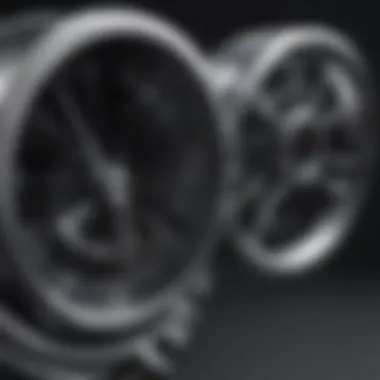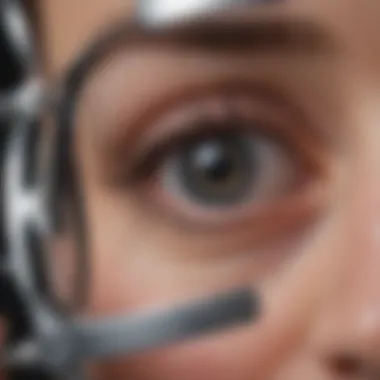Exploring Wilson Ophthalmic Instruments in Depth


Intro
Wilson ophthalmic instruments occupy a prominent place within the realm of eye care and surgery. These tools, known for their precision and reliability, have evolved significantly over time. Understanding their historical context, design intricacies, and clinical importance is crucial for both practitioners and students alike. This article navigates through the nuanced landscape of Wilson instruments, rendering insights that mark their role in modern ophthalmology.
Research Overview
Methodological Approaches
To comprehend the impact of Wilson ophthalmic instruments, a multifaceted research approach is adopted. This involves not only a review of historical patents and designs but also an analysis of contemporary clinical practices utilizing these devices. Surveys conducted among ophthalmologists provide firsthand insights on the practical applications and effectiveness of these tools.
Additionally, a dive into academic literature reveals various studies focusing on the effectiveness of Wilson instruments in specific procedures, such as cataract surgeries and retinal examinations.
Significance and Implications
The implications of using high-quality instruments in ophthalmology extend far beyond mere convenience. Precision in diagnosis directly correlates with patient outcomes. The analysis conducted underscores that instruments by Wilson facilitate detailed evaluations that guide surgical decisions. As advances in imaging and technology continue to permeate the field of ophthalmology, understanding the foundational role of such tools is essential for future innovation.
Current Trends in Science
Innovative Techniques and Tools
As we delve deeper into eye care technologies, it is essential to highlight the innovative techniques that enhance the efficacy of Wilson instruments. For instance, incorporation of advanced imaging systems with traditional surgical tools creates a synergy that improves diagnostic accuracy. Instruments are now designed with more ergonomic features and advanced materials that promote better usability and safety during procedures.
Interdisciplinary Connections
Examining Wilson ophthalmic instruments reveals their interdisciplinary connections within medical fields. Collaborations between ophthalmologists and biomedical engineers have resulted in the development of high-precision tools. The integration of artificial intelligence in diagnostic devices is a prime example of how these connections yield tangible benefits in practice. By combining insights from various disciplines, the future of vision care can become more innovative and responsive to the needs of patients.
"The quality of the instruments is as vital as the skill of the surgeon. Without precision tools, even the most skilled hands may falter."
In summary, the intricate role of Wilson ophthalmic instruments showcases their undeniable significance in modern eye care. Through examining their development and current trends, healthcare professionals can better appreciate the importance of precision in both diagnostics and surgical interventions.
Foreword to Wilson Ophthalmic Instruments
Understanding Wilson ophthalmic instruments is crucial in today's medical landscape. These tools play a significant role in the diagnosis and treatment of various eye conditions. This section establishes the foundation for exploring the historical evolution and operational mechanisms of these instruments. By examining their development and practical applications, we can appreciate how these tools contribute to enhanced patient care and clinical outcomes.
Historical Context
The history of Wilson ophthalmic instruments traces back to the early innovations in eye care. Before modern advancements, ophthalmology relied heavily on rudimentary tools. The early 20th century marked a transformative period, as medical technology rapidly evolved. Wilson Instruments began as a small enterprise focused on improving eye examination techniques. Over decades, the commitment to precision molded their path. This journey reflects broader advancements in medical instrumentation and an increasing understanding of ocular health. The historical significance of these instruments cannot be overstated, as they have influenced current practices and standards in ophthalmology.
Overview of Operations
Wilson ophthalmic instruments are designed to enhance evaluation and treatment procedures in eye care. They incorporate a diverse range of tools suited for diagnostics and surgical interventions. Operations typically involve the use of specialized equipment such as retinoscopes and slit lamps.
In clinical settings, these instruments are essential for various tasks:
- Conducting thorough eye examinations: Equipment like autorefractors assists in determining visual acuity accurately.
- Facilitating surgeries: Tools designed for cataract procedures or corneal surgery provide the precision needed in delicate operations.
- Ensuring effective patient outcomes: By utilizing advanced technology, practitioners can obtain reliable information and improve overall patient safety during medical interventions.
Detailed attention to operational standards ensures high reliability in performance and accuracy in results. As the landscape of eye care evolves, understanding these operational aspects becomes imperative for both practitioners and researchers.
Types of Instruments
Understanding the types of instruments used in ophthalmology is fundamental for a comprehensive grasp of Wilson Ophthalmic Instruments. These tools serve as essential components in diagnostics and surgical interventions. By examining the various categories of instruments, we can appreciate their specific roles and technologies, which ultimately enhance patient outcomes.
Diagnostic Instruments
Diagnostic instruments are crucial for accurate eye examinations. They facilitate the assessment of a patient's vision and the detection of ocular conditions. These tools equip healthcare professionals with the insights needed for proper diagnosis and treatment planning.
Retinoscopes
Retinoscopes are significant in the diagnostics sphere. They allow practitioners to evaluate refractive errors by assessing how light reflects off the retina. The key characteristic of retinoscopes is their ability to measure the refractive index of the eye effectively. This makes them a popular choice for eye exams, especially in pediatric populations.
A unique feature of retinoscopes is their simple operation, allowing even less experienced professionals to obtain valuable data. However, they do require a certain level of skill to interpret the results correctly, which can be seen as a disadvantage when compared to automated systems.


Slit Lamps
Slit lamps are fundamental in the evaluation of the anterior and posterior segments of the eye. They combine a light source with a microscope and provide a magnified view of eye structures. This high level of detail makes them advantageous for diagnosing various conditions, including cataracts and glaucoma.
The unique feature of slit lamps is their adjustable slit width, which allows for different lighting conditions and enhances visibility. However, they do require careful setup and proper technique from the user, which can be challenging in some clinical settings.
Autorefractors
Autorefractors offer a sophisticated method for measuring refractive error without patient input. These devices utilize automated technology to provide a reading notably faster than traditional methods. The key characteristic of autorefractors is their efficiency, which speeds up the diagnostic process greatly.
A distinct feature of autorefractors is their ability to store and retrieve past patient data, enhancing continuity of care. However, they may not always replace the need for subjective assessments, as individual patient feedback remains critical in refraction plotting.
Surgical Instruments
Surgical instruments in ophthalmology are designed for performing various eye surgeries, ensuring precision and safety. These tools are developed with advanced engineering techniques to minimize risks while maximizing effectiveness.
Cataract Surgery Devices
Cataract surgery devices are a cornerstone of modern ophthalmic surgery. They are specifically designed to facilitate the removal of cataracts, which are cloudy lenses in the eye. What makes them a beneficial choice is their innovative technology that ensures less invasive procedures, leading to faster recovery times.
One unique feature of these devices is the phacoemulsification technique, which uses ultrasonic vibrations to break up the lens. Although highly effective, the necessary skill and experience for proper instrument handling can be a challenge for less experienced surgeons.
Laser Instruments
Laser instruments play a transformative role in ocular surgeries. This category includes devices for refractive surgeries, such as LASIK. The significant characteristic of laser instruments is their precision, allowing for highly targeted treatments with minimal collateral damage to surrounding tissues.
A distinct feature is their real-time tracking systems, which improve safety and outcomes. However, the cost and complexity of these devices can be seen as a disadvantage when considering implementation in various clinical settings.
Corneal Surgery Tools
Corneal surgery tools are essential when performing procedures that involve the cornea, including corneal transplants or keratoplasty. They represent a critical evolution in surgical options available to eye care professionals. These tools are beneficial for their specificity and adaptability to varied surgical approaches.
One unique feature of corneal surgery tools is the availability of handheld devices that expand surgeon capabilities in different environments. However, learning to use these tools proficiently can require significant time and resources in training for healthcare providers.
Design and Manufacturing Standards
The design and manufacturing standards of Wilson ophthalmic instruments play a crucial role in ensuring their effectiveness and reliability. The intricate nature of ophthalmic procedures demands that every instrument be crafted with a high level of precision and care. Focus on this area helps not just in performance but also in patient safety and satisfaction.
Material Selection
Choosing the right materials is a key factor in the quality of ophthalmic instruments.
Biocompatible Materials
Biocompatible materials are essential in ophthalmic instruments as they interact safely with human tissue. These materials minimize the risk of adverse reactions during and after procedures. A key characteristic of biocompatible materials is their ability to integrate well with biological systems without causing inflammation or infection.
When it comes to eye care, the use of materials like silicone and certain polymers enhances the safety profile of surgical instruments. Their unique feature is the ability to sustain their integrity under varying conditions, such as exposure to body fluids. This ensures a patient-friendly approach while providing the necessary durability. The advantages of using such materials far outweigh the disadvantages, making them a popular choice in crafting instruments needed for eye surgeries and diagnostics.
Durability Considerations
Durability in ophthalmic instruments is another emphasis that clinics and hospitals prioritize. Instruments need to withstand frequent use while maintaining performance accuracy.
A distinctive characteristic of durability considerations is the resilience of materials to wear and tear. Instruments used in surgeries must not fail under stress; therefore, they are often manufactured from high-grade metals and alloys. This reliability becomes essential during critical surgical procedures. While the main advantages include longer lifespan and reduction in replacement costs, choosing durable materials can sometimes have a higher upfront cost to consider.
Precision Engineering
Precision engineering is vital in the crafting of ophthalmic instruments. It refers to the meticulous processes involved in producing instruments that meet strict specifications.
Manufacturing Techniques
The manufacturing techniques utilized in producing Wilson ophthalmic instruments reflect the importance of accuracy. Techniques such as CNC (computer numerical control) machining allow for micro-level precision that is critical in ophthalmic tools. This method is favored because it ensures each instrument is consistent in dimensions and functional efficiency.


Furthermore, the unique feature of these techniques is their capability to produce complex shapes that traditional methods may struggle with. Advantages include enhanced instrument performance and reduced risk of human error during production. Despite the benefits, initial costs for high-precision machinery can be substantial, which is a consideration for manufacturers.
Quality Control Protocols
Quality control protocols are the cornerstone of trust within the manufacturing process of ophthalmic instruments. They involve systematic inspections and testing to ensure instruments meet required standards before reaching the clinician. A key characteristic of these protocols is their ability to catch defects early in the production cycle, thus maintaining product integrity.
Protocols such as ISO certification provide reassurance about the reliability of the instruments used in sensitive procedures. Their unique aspect is the structured approach to quality assurance, which can significantly minimize risks associated with surgical complications. While establishing comprehensive quality control can be resource-intensive, the ultimate outcome in terms of patient safety and satisfaction justifies the investment.
Clinical Applications
The clinical applications of Wilson ophthalmic instruments play a pivotal role in safeguarding and improving patient health. These instruments enable comprehensive eye assessments, which are crucial in diagnosing various ocular conditions. As the field of ophthalmology evolves, understanding the functionality and application of these tools becomes essential for practitioners. The following sections will elaborate on the specific domains where Wilson instruments significantly contribute.
Routine Eye Examinations
Routine eye examinations are fundamental in preserving vision and detecting potential medical issues early. Instruments like slit lamps and autorefractors are commonly employed during these assessments. Slit lamps provide a magnified view of the eye's anterior structures, allowing for detailed examination. Meanwhile, autorefractors assist in determining refractive errors with high accuracy, facilitating timely prescriptions for corrective lenses.
These examinations help not only in identifying common ailments such as myopia or hyperopia but also in detecting more serious conditions like glaucoma or cataracts. Early diagnosis can lead to better treatment outcomes and enhance patients' quality of life. Regular use of advanced diagnostics allows eye care professionals to track changes over time, ensuring ongoing patient management.
Surgical Procedures
Surgical procedures in ophthalmology benefit greatly from the precision of Wilson instruments. Tools designed for cataract surgery, such as phacoemulsifiers, enable surgeons to remove cloudy lenses effectively. Laser instruments, including those used in LASIK procedures, illustrate the remarkable advancements in surgical technology, allowing for enhanced outcomes and reduced recovery times.
These instruments must meet stringent standards to ensure safety and efficiency. Effective surgical tools improve patient results and have been shown to enhance overall satisfaction. Notably, the precision offered by modern surgical technology minimizes complications and supports quicker healing, fostering a more positive surgical experience.
Emergency Interventions
In emergency settings, the role of Wilson ophthalmic instruments becomes even more pronounced. Timely intervention is vital for conditions like retinal detachment or ocular trauma. Rapid assessment tools such as portable ultrasound can be instrumental in these acute situations. Emergency practitioners need to perform quick evaluations to determine the urgency of interventions required.
Additionally, instruments like digital fundus cameras can expedite the diagnosis of acute conditions, allowing for immediate treatment planning. The accessibility and reliability of these devices directly influence patient outcomes in emergent scenarios.
Effective clinical applications of ophthalmic instruments can be the difference between preserving sight and losing vision.
In summary, routine eye examinations, surgical procedures, and emergency interventions collectively represent the essence of Wilson ophthalmic instruments in clinical practice. Understanding these applications is crucial for healthcare providers aiming to improve patient care and outcomes.
Impact on Patient Outcomes
The impact of Wilson ophthalmic instruments on patient outcomes is a critical aspect of modern eye care. Understanding how these instruments contribute to effective diagnosis and treatment can significantly affect quality of care. This section will explore several key areas, including the accuracy in diagnosis, safety in surgical procedures, and the results observed in the post-operative phase.
Accuracy in Diagnosis
The accuracy of a diagnosis plays a key role in the overall treatment of eye conditions. Wilson ophthalmic instruments, such as retinoscopes and autorefractors, are designed to provide precise measurements of refractive errors and other ocular conditions. This precision allows ophthalmologists to develop tailored treatment plans for individual patients. With enhanced diagnostic accuracy, patients receive the appropriate interventions sooner, thus minimizing complications that can arise from untreated or misdiagnosed conditions. Inaccurate diagnostics can lead to inappropriate treatments, potentially resulting in further health issues or a deteriorating quality of life for patients.
Safety in Surgical Details
Surgical safety is paramount in ophthalmology. Instruments designed by Wilson adhere to stringent engineering and safety standards. Tools like cataract surgery devices and laser instruments are crafted to minimize the risk of complications during operations. Their design prioritizes ergonomics and usability, allowing surgeons to perform delicate procedures with greater ease. This reduces the likelihood of human error during surgeries. The implementation of advanced technology in these instruments further enhances safety. For example, laser technology has improved precision in eye surgeries, leading to fewer post-surgical complications.
Post-Operative Results
Post-operative outcomes can significantly determine the success of ophthalmic procedures. Instruments used during surgery, such as corneal surgical tools, are vital for ensuring that interventions lead to positive recovery results. Research shows that patients treated with high-precision instruments often experience quicker recovery times and better long-term visual outcomes. Monitoring tools also play an essential role in the post-operative phase, helping healthcare providers track recovery and detect any issues early. Effective communication between healthcare providers about the use of these instruments fosters a collaborative environment that further enhances patient care.
"The accuracy and safety provided by Wilson's ophthalmic instruments are essential for achieving optimal patient outcomes in eye care."
Technological Advancements
Technological advancements in ophthalmic instruments play a crucial role in enhancing diagnosis, treatment, and management of eye disorders. With rapid changes in technology, the capabilities of these instruments have significantly improved. The incorporation of advanced materials and methods has led to the development of tools that are not only more precise but also more user-friendly. These improvements have a direct impact on patient outcomes and clinical workflows.
Digital Innovations
Digital innovations are reshaping how eye care professionals conduct assessments and deliver treatment. Traditional methods for diagnosis often relied on analog systems, which have limitations in accuracy and data storage. The transition to digital diagnostic tools provides ophthalmologists with the ability to capture high-resolution images and conduct more detailed measurements. This improvement increases the chance of early detection of eye conditions, which is critical in preventing vision loss.
Some significant examples include:


- Fundus Cameras: These devices now utilize digital imaging technology, allowing detailed views of the retina. This is crucial for diagnosing diseases such as diabetic retinopathy and glaucoma.
- Optical Coherence Tomography (OCT): OCT devices have advanced in imaging speed and resolution, giving practitioners the ability to view the microanatomy of the retina.
- Telemedicine Solutions: The rise of digital platforms facilitates remote consultations and monitoring, expanding access to eye care, especially in underserved regions.
With digital advancements, data management becomes more effective. Electronic Health Records (EHRs) and cloud storage offer seamless access to patient history, enhancing the continuity of care.
Artificial Intelligence in Ophthalmology
Artificial Intelligence (AI) is beginning to transform the landscape of ophthalmic diagnostics and treatment. The integration of machine learning algorithms in data analysis opens up new possibilities for patient care.
AI can assist in:
- Predictive Analytics: With large datasets, AI algorithms can identify patterns that may not be evident to clinicians. This capacity can lead to earlier interventions and better patient outcomes.
- Diagnostic Support: Various AI applications are being developed to assist in interpreting imaging from OCT and fundus cameras. This support is particularly beneficial for complex cases needing detailed analysis.
- Workflow Optimization: AI can streamline administrative tasks, scheduling, and follow-ups, allowing practitioners to focus more on patient care.
"The utilization of AI in eye care not only improves precision but also enables personalized medicine, tailoring treatments to individual needs."
Future of Wilson Instruments
The future of Wilson ophthalmic instruments presents an exciting landscape within the realm of vision care. Continual advancements and shifting paradigms within technology signify both challenges and opportunities as this field evolves. This section will delve into the emerging trends shaping the direction these instruments may take in the coming years, along with the key elements that will dictate their development and use.
Emerging Trends
Miniaturization
The trend of miniaturization is crucial in the evolution of ophthalmic instruments. This focuses on reducing the size of devices without sacrificing functionality. The popularity of miniaturized instruments lies in their enhanced portability and ease of use in various settings, including conducting eye examinations in remote areas.
Key characteristics of miniaturization include reduced weight and space requirements. By making instruments smaller, practitioners can store and transport them more easily. This is particularly beneficial in emergency medical situations where time and efficiency are paramount. Additionally, patients often find miniaturized instruments less intimidating, potentially improving their overall experience and compliance during diagnostics and treatments.
However, miniaturization does come with certain challenges. One unique aspect is the potential for decreased durability. Smaller components may be more susceptible to damage, necessitating rigorous testing and quality control. Therefore, striking a balance between size and stability becomes essential in the ongoing development of these instruments.
Miniaturization promotes accessibility in ophthalmic care, allowing practitioners to reach communities that are often underserved.
Sustainability Considerations
Sustainability considerations increasingly shape the design and functionality of ophthalmic instruments. The focus is on reducing environmental impact as the industry recognizes its responsibility towards the planet. Sustainable practices in manufacturing can lead to more responsible sourcing of materials and reduction of waste.
A key characteristic of sustainability is the use of eco-friendly materials that do not compromise the functionality of the devices. This resonates well with the growing awareness among consumers regarding environmental issues, marking it as a strong choice for future designs. Furthermore, integrating sustainability into instrument production can enhance a company’s reputation among customers who prioritize environmentally-friendly practices.
Among the distinctive features of sustainability in this context is the potential for lifecycle management of instruments. Sustainable design considers the end-of-life stage of products, ensuring they can be recycled or responsibly disposed of, which can mitigate negative impacts on ecosystems. Nonetheless, sustainability often requires upfront investment in research and development, which could be viewed as a disadvantage for some manufacturers.
Research and Development Priorities
Effective research and development are critical in maintaining the relevance of Wilson ophthalmic instruments. It is essential to identify the priorities that will drive innovation and effectiveness within the field. Specific areas include enhancing diagnostic imaging technology, improving surgical instrumentation, and incorporating telemedicine capabilities.
As technology continues to advance, the integration of artificial intelligence may play a pivotal role in developing intelligent systems that assist practitioners in making informed decisions. Investment in research aimed at understanding the latest diseases and their impact on eye health will also be paramount.
In summary, the future of Wilson instruments sits at the crossroads of miniaturization and sustainability, backed by research and development priorities that hold the promise of elevating patient care and expanding access to eye health services.
Ending
The conclusion of this article serves as a critical reflection on the various aspects of Wilson ophthalmic instruments. It encapsulates the significance of these tools in both diagnostics and surgical applications within ophthalmology. As we explored earlier, the history, design, and clinical relevance of these instruments are pivotal in enhancing patient outcomes and ensuring safe procedures.
Summation of Insights
The insights gathered throughout this article emphasize the unique position held by Wilson instruments in modern ophthalmology. These devices are not merely tools; they are integral components that bridge the gap between patient care and technological progress. We have seen how the evolution of these instruments reflects advancements in both understanding of eye health and precision engineering.
- Precision in Diagnostics: Instruments like retinoscopes and slit lamps are crucial for accurate diagnosis, allowing practitioners to detect and treat conditions effectively.
- Surgical Excellence: The surgical instruments discussed, particularly cataract surgery devices, exemplify the need for high-quality and reliable tools that contribute to improved surgical outcomes.
In summary, Wilson ophthalmic instruments stand out not just for their functionality but for their profound impact on healthcare. They enhance the understanding of ocular health and push the boundaries of what is achievable in eye care.
Call for Future Research
While this article highlights significant strides in the field, it also calls attention to the ongoing need for research and development. The landscape of ophthalmic instruments is continuously evolving, driven by technological advancement. Here are some key considerations for future exploration:
- Innovation in Design: Research should focus on how new materials and technologies can further improve the effectiveness of these instruments.
- Integration of AI: Investigating the potential of artificial intelligence in diagnostics and surgical procedures could significantly change patient care paradigms.
The future of Wilson ophthalmic instruments lies not only in refining existing tools but also in exploring undiscovered avenues. As we continue to pursue knowledge in this field, collaboration between researchers, educators, and practitioners will be vital for fostering innovations that can enhance patient care and safety.
"Continuous improvement in ophthalmic technologies promises a brighter future for vision care across the globe."
The call for future research underscores the importance of maintaining a forward-thinking approach and underscores a commitment to elevating the standards of patient outcomes in the field.



